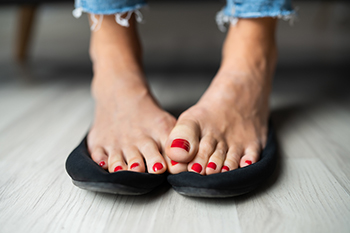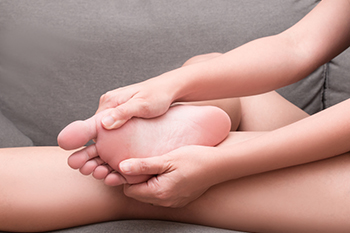
Most people experience sweaty feet from time to time, but excessive sweat under the feet can be a sign of plantar hyperhidrosis. Sweating is a part of our body’s way of cooling itself off and managing body temperature. Our feet have more sweat organs per inch than any other place in the body, and they can produce as much as half a quart of sweat per day. When it comes to controlling clammy feet, there are some things you can do for yourself and some things that might need medical attention. Cleanliness, shoes, socks, diet, and anxiety can influence how much your feet sweat. Hyperhidrosis is more common in men than women and in youth than grown-ups. If one has over the top sweating on their feet, it is likely that this happens to their palms as well. Feet that sweat too much may slip around inside of shoes. The feet might also have a whitish, wet appearance, and they may smell. These conditions are conducive to foot diseases, like a fungus. Adolescents are particularly sensitive about this ailment and the related foot odor at their age. To prevent sweaty feet, one should wash their feet regularly, dry them well, apply a moisturizer, and consider using antifungal powder or antiperspirant. Shoes should be rotated between use so that any moisture can dry out. Wearing shoes that are made of breathable material and fit well are imperative. Socks that wick moisture (cotton in warmer months and fleece or wool in cooler months) from the foot should be worn as well. Keep well hydrated. If regular foot care does not control your clammy feet, consult with a podiatrist who can provide additional suggestions for how to prevent and treat this annoying condition.
If you are suffering from hyperhidrosis contact Dr. Kevin Davis of Davis Foot & Ankle Centers. Our doctor can provide the care you need to attend to all of your foot and ankle needs.
Hyperhidrosis of the Feet
Hyperhidrosis is a rare disorder that can cause people to have excessive sweating of their feet. This can usually occur all on its own without rigorous activity involved. People who suffer from hyperhidrosis may also experience sweaty palms.
Although it is said that sweating is a healthy process meant to cool down the body temperature and to maintain a proper internal temperature, hyperhidrosis may prove to be a huge hindrance on a person’s everyday life.
Plantar hyperhidrosis is considered to be the main form of hyperhidrosis. Secondary hyperhidrosis can refer to sweating that occurs in areas other than the feet or hands and armpits. Often this may be a sign of it being related to another medical condition such as menopause, hyperthyroidism and even Parkinson’s disease.
In order to alleviate this condition, it is important to see your doctor so that they may prescribe the necessary medications so that you can begin to live a normal life again. If this is left untreated, it is said that it will persist throughout an individual’s life.
A last resort approach would be surgery, but it is best to speak with your doctor to find out what may be the best treatment for you.
If you have any questions please feel free to contact our office located in Springfield, TN . We offer the newest diagnostic and treatment technologies for all your foot and ankle needs.

Heel pain is experienced by many people. The foot condition known as plantar fasciitis is a leading cause of heel pain and it can be uncomfortable. The plantar fascia is a band of tissue that is located on the bottom of the foot and connects the heel to the toes. If this becomes inflamed for any reason, it could result in plantar fasciitis. Plantar fasciitis can happen from standing on hard surfaces for long periods throughout the day, or from wearing shoes that do not fit correctly. Additionally, it may occur in people who frequently participate in running and jumping activities, as this may put excess stress on the heel of the foot. The symptoms that are often associated with plantar fasciitis can include heel pain that is worse upon arising in the morning and often feels like a stabbing or shooting pain. This condition may be more prevalent among people who are over 50 years old, overweight, or who have high arches or tight calf muscles. Treatment methods may include wearing orthotics, performing specific types of stretches, or in severe cases, surgery may be necessary. If you have heel pain, please consult with a podiatrist who can effectively diagnose and treat plantar fasciitis.
Plantar fasciitis is a common foot condition that is often caused by a strain injury. If you are experiencing heel pain or symptoms of plantar fasciitis, contact Dr. Kevin Davis from Davis Foot & Ankle Centers. Our doctor can provide the care you need to keep you pain-free and on your feet.
What Is Plantar Fasciitis?
Plantar fasciitis is one of the most common causes of heel pain. The plantar fascia is a ligament that connects your heel to the front of your foot. When this ligament becomes inflamed, plantar fasciitis is the result. If you have plantar fasciitis you will have a stabbing pain that usually occurs with your first steps in the morning. As the day progresses and you walk around more, this pain will start to disappear, but it will return after long periods of standing or sitting.
What Causes Plantar Fasciitis?
- Excessive running
- Having high arches in your feet
- Other foot issues such as flat feet
- Pregnancy (due to the sudden weight gain)
- Being on your feet very often
There are some risk factors that may make you more likely to develop plantar fasciitis compared to others. The condition most commonly affects adults between the ages of 40 and 60. It also tends to affect people who are obese because the extra pounds result in extra stress being placed on the plantar fascia.
Prevention
- Take good care of your feet – Wear shoes that have good arch support and heel cushioning.
- Maintain a healthy weight
- If you are a runner, alternate running with other sports that won’t cause heel pain
There are a variety of treatment options available for plantar fasciitis along with the pain that accompanies it. Additionally, physical therapy is a very important component in the treatment process. It is important that you meet with your podiatrist to determine which treatment option is best for you.
If you have any questions, please feel free to contact our office located in Springfield, TN . We offer the newest diagnostic and treatment technologies for all your foot care needs.

Sesamoiditis is a potentially uncomfortable and painful condition that can threaten the health and vitality of your feet. The condition occurs when the two bones under the big toe joint, known as the sesamoid bones, become inflamed and irritated. This inflammation can occur in response to an injury or chronic causes. If you have sesamoiditis, you can experience a number of different symptoms. Most likely, you will experience pain when conducting weight-bearing activities or when applying pressure to the sesamoid bones. This condition can be painful and irritating, but there are several steps that you can take to mitigate its effects. Firstly, you can wear custom-made orthotics, or shoe inserts, that help you walk without putting pressure on the sesamoid bones. Altering your footwear may also help in reducing pain if you can find a pair of shoes that reduces the amount of pressure you exert on your big toe. In treating your sesamoiditis, you might also try to alter your daily routine to eliminate activities that put excess pressure on the feet and the sesamoid bones. If none of these or other treatments seem to reduce the pain felt from sesamoiditis, a surgical procedure may help provide the needed relief. If you believe that you might have sesamoiditis, it is always best to consult a podiatrist who will be able to properly diagnose your problem and propose a treatment plan.
Sesamoiditis is an unpleasant foot condition characterized by pain in the balls of the feet. If you think you’re struggling with sesamoiditis, contact Dr. Kevin Davis of Davis Foot & Ankle Centers. Our doctor will treat your condition thoroughly and effectively.
Sesamoiditis
Sesamoiditis is a condition of the foot that affects the ball of the foot. It is more common in younger people than it is in older people. It can also occur with people who have begun a new exercise program, since their bodies are adjusting to the new physical regimen. Pain may also be caused by the inflammation of tendons surrounding the bones. It is important to seek treatment in its early stages because if you ignore the pain, this condition can lead to more serious problems such as severe irritation and bone fractures.
Causes of Sesamoiditis
- Sudden increase in activity
- Increase in physically strenuous movement without a proper warm up or build up
- Foot structure: those who have smaller, bonier feet or those with a high arch may be more susceptible
Treatment for sesamoiditis is non-invasive and simple. Doctors may recommend a strict rest period where the patient forgoes most physical activity. This will help give the patient time to heal their feet through limited activity. For serious cases, it is best to speak with your doctor to determine a treatment option that will help your specific needs.
If you have any questions please feel free to contact our office located in Springfield, TN . We offer the newest diagnostic and treatment technologies for all your foot and ankle needs.

Countless Americans choose to get their daily dose of exercise and movement from walking and running. If you are one such person, it is imperative that you make yourself well acquainted with the critical differences between walking and running shoes. Despite the surface-level similarities between walking and running as activities, shoes for each activity are built differently to suit the differences between the activities. For example, running shoes have thicker and sturdier heel cushions than walking shoes. This is because the act of running requires putting more pressure and weight on the heel area of the foot. Running shoes also have wider heel cushions to provide the extra needed stability for runners. Additionally, running and walking shoes are different from each other because the former relies more heavily on having a sturdy mid-sole to essentially absorb the high impact running puts on the joints. Shock absorption is more important in running shoes because while running, individuals can put up to 200 pounds of weight impact onto their feet. You can use this information about the differences between walking and running shoes when shopping for both to know what features you should be on the lookout for. A podiatrist can help further clarify the differences and importance between these shoes.
For more information about walking shoes versus running shoes, consult with Dr. Kevin Davis from Davis Foot & Ankle Centers. Our doctor can measure your feet to determine what your needs are and help you find an appropriate pair of footwear.
Foot Health: The Differences between Walking & Running Shoes
There are great ways to stay in shape: running and walking are two great exercises to a healthy lifestyle. It is important to know that running shoes and walking shoes are not interchangeable. There is a key difference on how the feet hit the ground when someone is running or walking. This is why one should be aware that a shoe is designed differently for each activity.
You may be asking yourself what the real differences are between walking and running shoes and the answers may shock you.
Differences
Walking doesn’t involve as much stress or impact on the feet as running does. However, this doesn’t mean that you should be any less prepared. When you’re walking, you land on your heels and have your foot roll forward. This rolling motion requires additional support to the feet.
Flexibility – Walking shoes are designed to have soft, flexible soles. This allows the walker to push off easily with each step.
If you have any questions, please feel free to contact our office located in Springfield, TN . We offer the newest diagnostic and treatment technologies for all your foot care needs.
